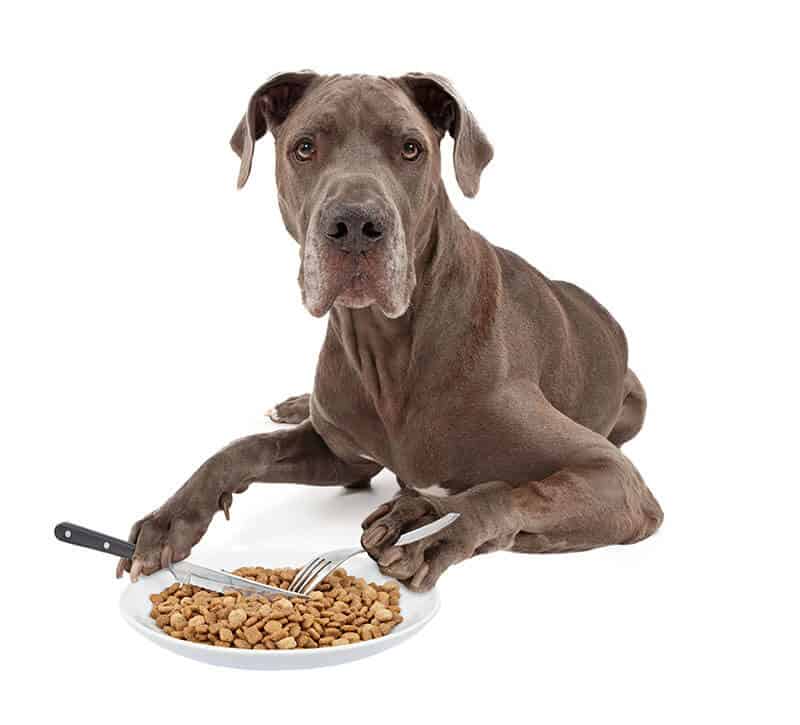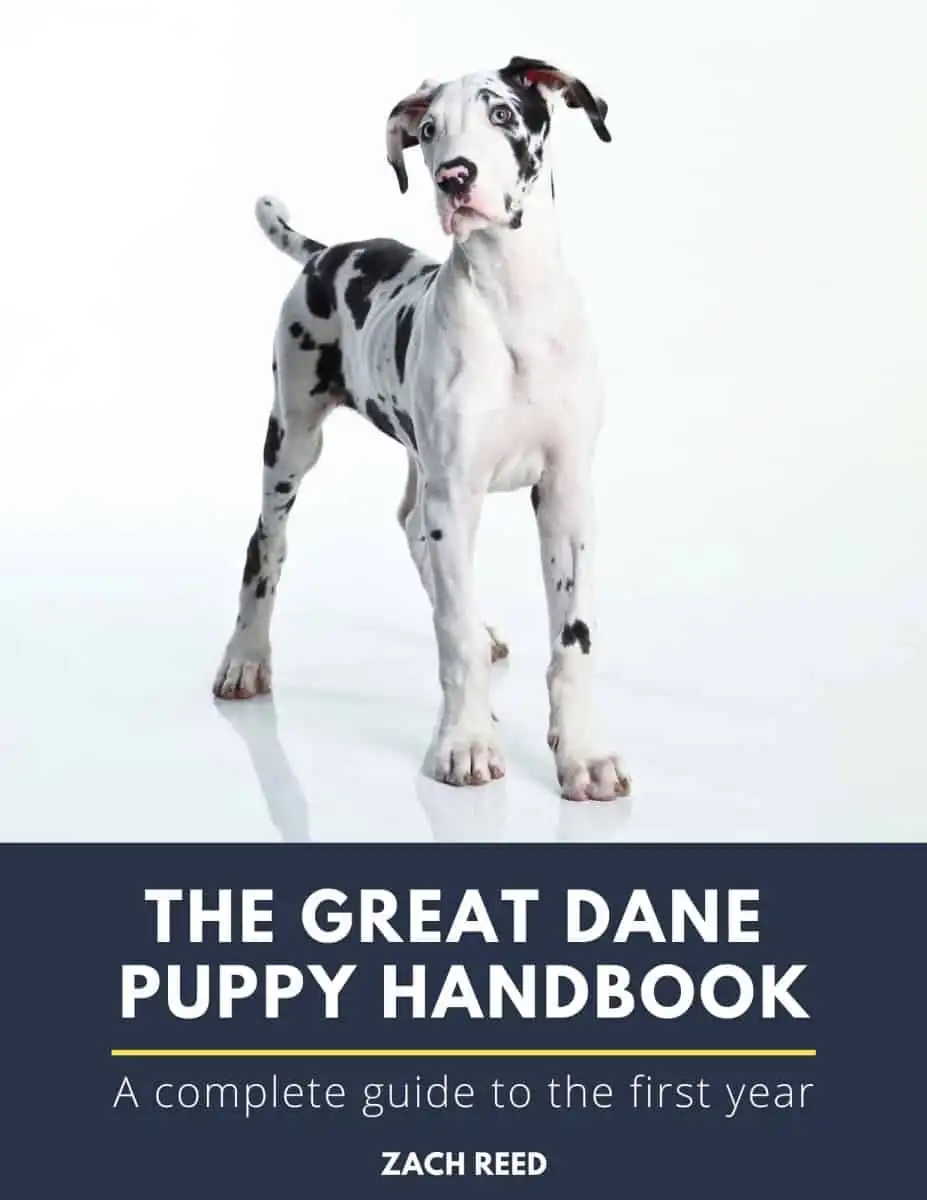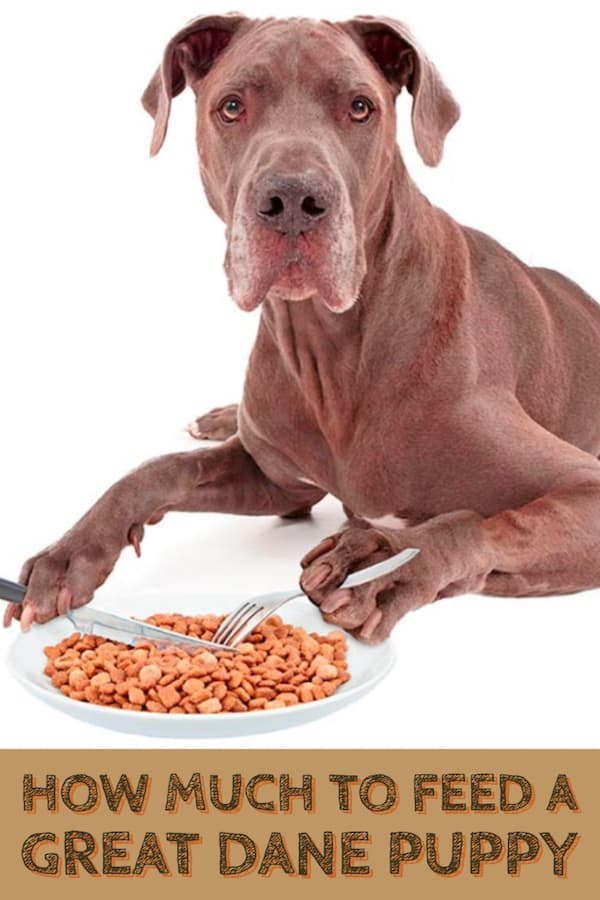How to Feed a Great Dane
Join the Great Dane Care Newsletter!
Free access to exclusive tips, tricks, puppy info, training, and more.
Hopefully, you are reading this article before bringing home your Great Dane puppy! If not, we'll get straight to the answer so that you learn how much to feed your Great Dane puppy.
Next to water and sleep, providing them with food is one of the most important tasks for their survival. Due to the extreme growth that a Great Dane will experience in their first years of life, proper nutrition is critical to their long-term health and longevity.
Rapid weight gain can place excessive stress on their joints, which could lead to orthopedic issues later in life. Overfeeding can also lead to other issues such as knuckling over, bowed legs, Hypertrophic Osteodystrophy (HOD), Osteochondritis Dissecans (OCD), and Panosteoitis or "Pano".
These issues can be seen in both large and giant breeds, where there is extreme growth in their early stages of life.
While they typically appear between months 2 and 7, the most common period for Great Danes to see the occurrence of a growth disease is between months 2 and 4. Male and female Great Danes seem to be equally affected.
So, how much should someone feed a Great Dane Puppy? Great Dane puppies should be fed between 2-3 meals per day depending on their age. Follow the Great Dane feeding chart below for specific recommended amounts.
| Age [months] | Food [cups] | Meals / day |
| 2 | 2 – 4 | 3 |
| 3 | 3 – 5 | 3 |
| 4 | 4 – 6 | 3 |
| 5 | 5 – 7 | 2 |
| 6 | 6 – 8 | 2 |
| 7 | 6 – 9 | 2 |
| 8 | 6 – 9 | 2 |
| 9 | 7 – 10 | 2 |
| 10 – 12 | 7 – 10 | 2 |
| 12 – 18 (females) | 6 – 9 | 2 |
| 12 – 18 (males) | 7 – 10 | 2 |
These details may seem straightforward, but there are additional keys that you should follow to know how to increase their food as well as indicators for when they are getting too heavy or too skinny!

How Much To Feed A Great Dane Puppy
The total food for a day should be evenly divided across each of the meals. Slowly increase the food throughout the month to match their increasing energy needs as they continue to grow.
The number of meals that the food should be spread across is also listed. Noticed how it transitions from 3 meals per day to 2 meals per day once they reach 5 months of age.
Females should start at the bottom of the range for a given month, and slowly have their food increased until reaching the low end of the following month. This should be a gradual increase that is spread evenly across the month's timeframe.
For example, a 3-month-old female would begin the month eating a total of 3 cups of food per day. Midway through the month, her daily food total would be at 3.5 cups. Finally, ending the month at 4 cups of food daily.
Males should start in the middle of the range, and slowly have their food increased until reaching the middle of the range for the following month. As with females, this should be a gradual increase spread over the course of the month.
As an example, a 5-month-old male would begin the month eating a total of 6 cups of food per day. Midway through the month, his daily food total would be at 6.5 cups. Finally, ending the month at 7 cups of food daily.
Great Dane Feeding Chart by Month
| Age [months] | Food [cups] | Meals / day |
| 2 | 2 – 4 | 3 |
| 3 | 3 – 5 | 3 |
| 4 | 4 – 6 | 3 |
| 5 | 5 – 7 | 2 |
| 6 | 6 – 8 | 2 |
| 7 | 6 – 9 | 2 |
| 8 | 6 – 9 | 2 |
| 9 | 7 – 10 | 2 |
| 10 – 12 | 7 – 10 | 2 |
| 12 – 18 (females) | 6 – 9 | 2 |
| 12 – 18 (males) | 7 – 10 | 2 |
Exclusive Bonus: Download our free meal plan reference chart for quick and easy access later. This will save you from trying to remember all these details down the road or find this page again. Plus – it's nicely formatted so that you can print it!
Meal Plan Recap
Many Great Danes will not reach their full size and weight until three years of age. There should be no rush to bulk them up early or have the biggest pup in town. The goal should be to keep them light and lean until they reach the age of two.
Also, note that these are general guidelines for your Dane. If you notice them getting too lean then increase the amount of food. Lean is good, but being too skinny will limit their development.
For a quick visual indicator, you should be able to see their last rib when are standing when they are at the correct weight.
Likewise, if you're no longer able to see their last rib then they're probably past the "long and lean" stage. Hold off on increasing their food intake until they return to the proper body composition level.
Be Wary of "Puppy Food"
Puppy food or growth formulas are not necessary for Great Dane puppies. In fact, they can be bad for them if not properly balanced!
Great Dane puppies will grow fast enough on their own without any "extra" help. Most puppy formulas will only increase the chance of suffering one of the growth diseases or joint problems previously mentioned.
There are also large breed-specific dog foods available that help promote a normal growth rate. This will allow the Great Dane's bones and muscles to develop at a typical speed.
The dog should get food that contains up to 26 percent protein and between 12 and 20 percent fat for optimal health. This ensures that they receive the correct caloric balance to avoid negatively affecting their growth.
As with most situations, there is a caveat for puppy food. Research indicates that in addition to the protein ratio, the micronutrient composition should also be considered.
Especially, that of calcium and phosphorus.
Puppy food brands containing less than 1.5% calcium, ideally closer to 1% can also be viewed as safe. The amount of phosphorus present should represent a ratio to that of calcium. The ideal range is considered to be a minimum of 1:1, but not more than 1.5:1 (calcium to phosphorus).
Consult with your veterinarian for assistance in selecting a brand the delivers all of the proper nutrients for your puppy. They will likely recommend brands that avoid corn-based fillers, include all-natural ingredients, and opt to include a variety of protein sources. You can also reference our dedicated article on the best food for Great Danes here.
The days of basic dog food are long past. The selection of high-quality premium food will go a long way in ensuring the health and longevity of your Great Dane.
Best Seller

For more information about these specifics, make sure to take a look at my dedicated article on puppy food for Great Danes.
How To Change Foods (If Necessary)
In the event that you decide to change your Great Dane puppy's food, you should not do so "cold turkey".
An immediate change over between meals would be very tough on their stomachs leading to diarrhea, vomiting, or disruption of their growth pattern.
Look to transition them fully from the old to the new food in three meals. The first meal would be a mixture of 50% old food, 50% new food. Meal two would consist of 25% old food, 75% new food. Finally, the third meal would consist of 100% new food.
Pro Tip! You can further smooth the transition by sprinkling a probiotic powder on top of the food before giving it to them.
We particularly like the one made by NaturVet (link to Amazon) because it's manufactured in the USA in CGMP facilities and carries the National Animal Supplement Council seal.
What To Do If They Don't Eat
Great Danes can be notoriously picky eaters. They wolf down their food one day and prefer to sleep through breakfast the next. Unless they show other signs of sickness such as vomiting or lethargy then it's probably nothing to be concerned about.
Their appetites can fluctuate as they go through growth spurts and their hormones are fluctuating. This is typically more common after they get past twelve months of age and the periods of peak growth have passed.
Simply remove the meal if they have not finished it within a reasonable amount of time and resume back on their normal feeding schedule.
Continuous feeders should be avoided as they risk overfeeding your Great Dane and leading to possible orthopedic issues.
Raised Food Bowls
To lessen the risk of digestive issues it is recommended to use an elevated feeder. This should hold both their food and water bowls to reach an appropriate height.
Unfortunately, the jury is still out whether or not this increases or decreases the chances of bloat / GDC. However, it's obvious that an elevated feeder creates a more comfortable feeding position, especially as they age.
For more information on this topic, take a look at our dedicated article on elevated feeders.
Where To Get Food
Leveraging online services such as chewy.com not only give you the benefit of good prices and a wide selection, but also the convenience of scheduled auto-ships.
We have used
This helps to prevent a scenario where you might accidentally run out of food and need to feed them a different brand temporarily that leads to intestinal distress for your Great Dane.
They have very sensitive stomachs and do not handle food changes very well.
Knowing if any local pet stores also carry your Great Dane's premium brand is useful in the event that you do need to make an emergency run to the store. Unfortunately, this is not always an option as many only carry commercial dog foods.
Once again, why our stalwart recommendation for many years stays with
What To If They Have Diarrhea
Many Great Danes experience occasional diarrhea due to their sensitive stomachs. Luckily not every instance will require a trip to the vet, which could get pricey very quickly!
You can help to soothe it by ensuring that they:
- Have plenty of clean water
- Cooking them a small bowl of boiled white chicken meat and white rice for a meal or two
- Adding some all-natural canned pumpkin puree to their meal
Extended bouts of diarrhea or occurrence with other symptoms such as vomiting, lethargy, or weight loss likely indicate something more serious.
Contact your veterinarian to provide treatment for the Great Dane.
Avoid Play Around Meals
Playtime should be limited for the hour preceding and following meal times to lessen the chances of bloat or GDV. Although listed last, it's a very important step to observe for their long-term health and longevity.
Pro Tip! If you're looking for the ultimate guide to caring for your Great Dane, then we highly recommend that you take a look at our ebook "The
We hope that you found this information helpful. Before you go, make sure to take a look at our favorite products for Great Danes!

Source: https://greatdanecare.com/feed-great-dane-puppy/
Posting Komentar untuk "How to Feed a Great Dane"